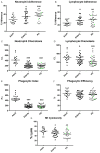Lymphoproliferation Impairment and Oxidative Stress in Blood Cells from Early Parkinson's Disease Patients
- PMID: 30759742
- PMCID: PMC6386872
- DOI: 10.3390/ijms20030771
Lymphoproliferation Impairment and Oxidative Stress in Blood Cells from Early Parkinson's Disease Patients
Abstract
In Parkinson's Disease (PD), the peripheral changes in the functional capacity and redox state of immune cells has been scarcely investigated, especially in the early PD stages. Aging is a risk factor for PD, and the age-related impairment of the immune system, based on a chronic-oxidative stress situation, is involved in the rate of aging. We analyzed several functions in isolated peripheral blood neutrophils and mononuclear cells from PD stage 2 patients, and compared the results to those in healthy elderly and adult controls. Several oxidative stress and damage parameters were studied in whole blood cells. The results showed an impairment of the lymphoproliferative response in stimulated conditions in the PD patients compared with age-matched controls, who also showed typical immunosenescence in comparison with adult individuals. Higher oxidative stress and damage were observed in whole blood cells from PD patients (lower glutathione peroxidase activity, and higher oxidized glutathione and malondialdehyde contents). Our results suggest an accelerated immunosenescence in PD stage 2, and that several of the parameters studied could be appropriate peripheral biomarkers in the early stages of PD.
Keywords: Parkinson’s Disease; biomarkers; blood cells; immune functions; immunosenescence; lymphoproliferation; oxidative damage; oxidative stress.
Conflict of interest statement
The authors declare no conflict of interest.
Figures



Similar articles
-
Impairment of Several Immune Functions and Redox State in Blood Cells of Alzheimer's Disease Patients. Relevant Role of Neutrophils in Oxidative Stress.Front Immunol. 2018 Jan 11;8:1974. doi: 10.3389/fimmu.2017.01974. eCollection 2017. Front Immunol. 2018. PMID: 29375582 Free PMC article.
-
Serum glutathione peroxidase, xanthine oxidase, and superoxide dismutase activities and malondialdehyde levels in patients with Parkinson's disease.Neurol Sci. 2017 Mar;38(3):425-431. doi: 10.1007/s10072-016-2782-8. Epub 2016 Nov 30. Neurol Sci. 2017. PMID: 27900485
-
[Study on changes of plasma levels of oxidative stress biomarkers and its relation with cognition function in patients with parkinson's disease].Zhonghua Yi Xue Za Zhi. 2015 Nov 3;95(41):3357-60. Zhonghua Yi Xue Za Zhi. 2015. PMID: 26812976 Chinese.
-
The glutathione system in Parkinson's disease and its progression.Neurosci Biobehav Rev. 2021 Jan;120:470-478. doi: 10.1016/j.neubiorev.2020.10.004. Epub 2020 Oct 14. Neurosci Biobehav Rev. 2021. PMID: 33068556 Review.
-
Metals and Parkinson's Disease: Mechanisms and Biochemical Processes.Curr Med Chem. 2018;25(19):2198-2214. doi: 10.2174/0929867325666171129124616. Curr Med Chem. 2018. PMID: 29189118 Review.
Cited by
-
Elevated Serum Xanthine Oxidase and Its Correlation with Antioxidant Status in Patients with Parkinson's Disease.Biomolecules. 2024 Apr 18;14(4):490. doi: 10.3390/biom14040490. Biomolecules. 2024. PMID: 38672506 Free PMC article.
-
Molecular phenotypes of mitochondrial dysfunction in clinically non-manifesting heterozygous PRKN variant carriers.NPJ Parkinsons Dis. 2023 Apr 18;9(1):65. doi: 10.1038/s41531-023-00499-9. NPJ Parkinsons Dis. 2023. PMID: 37072441 Free PMC article.
-
T-cell lymphocytes' aging clock: telomeres, telomerase and aging.Biogerontology. 2024 Apr;25(2):279-288. doi: 10.1007/s10522-023-10075-6. Epub 2023 Nov 2. Biogerontology. 2024. PMID: 37917220 Review.
-
Oxidative Stress in Parkinson's Disease: Potential Benefits of Antioxidant Supplementation.Oxid Med Cell Longev. 2020 Oct 12;2020:2360872. doi: 10.1155/2020/2360872. eCollection 2020. Oxid Med Cell Longev. 2020. PMID: 33101584 Free PMC article. Review.
-
The Role of Immune Cells in Oxi-Inflamm-Aging.Cells. 2021 Nov 1;10(11):2974. doi: 10.3390/cells10112974. Cells. 2021. PMID: 34831197 Free PMC article. Review.
References
MeSH terms
Substances
LinkOut - more resources
Full Text Sources
Medical

